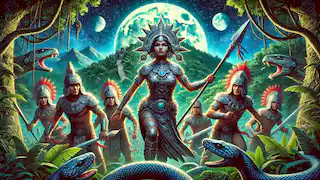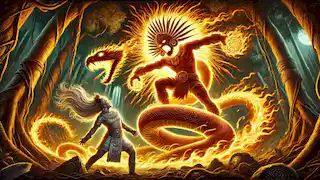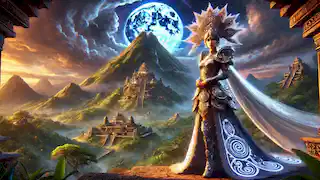In the deep jungles and mountainous terrains of ancient Mexico, long before the rise of mighty empires and the grandeur of cities like Tenochtitlán, there lived gods and goddesses who shaped the fate of the world. Among these divine figures, Coyolxauhqui, the moon goddess, played a pivotal role. Her story, one of love, power, betrayal, and cosmic battles, resonates through the ages, reminding us of the eternal struggle between creation and destruction.
Coyolxauhqui was the daughter of Coatlicue, the Earth Mother, revered and feared by all for her terrifying appearance. Her body was draped in a serpent skirt, and her necklace was made of human hearts, hands, and skulls. Yet, despite her fearsome exterior, Coatlicue was the life-giver, nurturing all forms of existence. Her children, Coyolxauhqui and her siblings, the Centzon Huitznahua—four hundred southern stars—were the embodiment of celestial forces, and together, they lived in harmony atop the sacred mountain Coatepec.
But as with many legends, peace was fleeting. What transpired next would set the cosmos ablaze and forever alter the balance of the heavens. The tranquil days on Coatepec, or Snake Mountain, came to an abrupt end when Coatlicue received an unexpected gift from the heavens—a ball of hummingbird feathers. This was no ordinary token; it was a divine message, a harbinger of a new birth. When Coatlicue tucked the feathers into her bosom, she became mysteriously pregnant with Huitzilopochtli, the god of the sun and war. Coyolxauhqui, who loved her mother dearly, was the first to notice this strange occurrence. To her, it was an omen—one that did not bode well. The stars began to whisper in her ears, telling her of a great prophecy, one that foretold her doom. Huitzilopochtli, her soon-to-be-born brother, was destined to rise as a powerful god, and with his ascent, the destruction of Coyolxauhqui and her star siblings would follow. The very thought of this sent a chill down her spine. Fear turned to anger, and anger, in turn, gave birth to a rebellion. Coyolxauhqui gathered the Centzon Huitznahua, her four hundred brothers, and shared her concerns. "This child our mother bears will bring about our downfall. The prophecy is clear: he will rise as the sun, and in his light, we, the stars, will perish." Her words struck a chord with her brothers. They were proud celestial beings, and the thought of being eclipsed by a mere infant filled them with dread. Coyolxauhqui, with fire in her heart, decided to act. She proposed a bold plan: to slay their mother before Huitzilopochtli was born and prevent the prophecy from unfolding. The Centzon Huitznahua, although hesitant at first, eventually agreed. Together, they set their sights on Coatlicue, and the plot to murder their own mother took shape. Coatlicue, unaware of her children's betrayal, continued her duties as the Earth Mother. She nurtured the land, brought forth the rains, and ensured the cycle of life continued. But deep inside, she could feel a great weight pressing down on her—a weight that grew heavier with each passing day of her pregnancy. It was as if the heavens themselves were preparing for a great battle. On the fateful day when Coyolxauhqui and her siblings decided to strike, the sky darkened, and the winds howled with a ferocity that had never been seen before. The time had come. As Coyolxauhqui led the charge up Coatepec, her mind raced with a mixture of emotions—rage, fear, and a hint of sorrow. After all, Coatlicue was her mother, the one who had given her life. But the thought of her own demise, of being erased from the cosmos, overshadowed any pangs of guilt she might have felt. Suddenly, as they approached the summit of the mountain, a brilliant light erupted from Coatlicue’s womb. Huitzilopochtli, the sun god, was born—fully grown and armed for battle. In one hand, he wielded the xiuhcoatl, a serpentine weapon of fire and light, and in the other, a round shield. His mere presence sent shockwaves through the stars. Coyolxauhqui’s heart sank as she realized the prophecy was true. Her brother, the child she sought to kill, was no ordinary god. He was the embodiment of the sun’s raw power, and his light would burn away the stars forever. But Coyolxauhqui was not one to back down. She drew her sword, a blade forged from moonlight, and charged at her newborn brother. The battle that ensued was nothing short of apocalyptic. Huitzilopochtli's xiuhcoatl slashed through the darkness, cutting down the Centzon Huitznahua with ease. Each strike of his weapon unleashed torrents of fire, and one by one, the stars fell from the heavens. Amidst the chaos, Coyolxauhqui stood tall, her silver armor gleaming under the moonlight. She faced Huitzilopochtli head-on, refusing to bow to the inevitability of her fate. “I will not be extinguished,” she declared. “I am the moon, and I shall shine even in your blinding light.” But Huitzilopochtli was relentless. He struck her with a fatal blow, and as the blade of fire tore through her body, Coyolxauhqui was flung from the heights of Coatepec, her severed head hurtling through the sky. Coyolxauhqui's fall was not swift. As she tumbled from the mountain, her once-beautiful form shattered into pieces. Her arms, legs, and torso scattered across the earth, and her head soared higher and higher until it reached the heavens. There, it transformed into the moon, a pale, scarred orb that would forever bear the marks of her defeat. Below, on the earth, Huitzilopochtli stood victorious. The Centzon Huitznahua were no more, their light extinguished by the might of the sun. Yet despite his triumph, Huitzilopochtli mourned the loss of his sister. He knew that without the stars, the night would be empty, and without the moon, the sky would lose its guiding light. To honor Coyolxauhqui, Huitzilopochtli decreed that her image would be etched into the earth itself. Thus, the great stone relief of Coyolxauhqui was created, depicting her fragmented body in all its glory. This stone would serve as a reminder of the cosmic battle that had taken place, and of the moon goddess’s sacrifice. The people of Mexico would come to revere this stone, offering it as a symbol of the eternal struggle between the forces of light and darkness, creation and destruction. For though Coyolxauhqui had been defeated, her spirit lived on in the cycles of the moon, waxing and waning with each passing month. Centuries passed, and the legend of Coyolxauhqui became deeply intertwined with the culture and religion of the Mexica people, who would later be known as the Aztecs. The grand city of Tenochtitlán was built upon the shores of Lake Texcoco, and in the heart of this city stood the Templo Mayor, the great pyramid dedicated to the gods. At the base of the pyramid lay the Coyolxauhqui Stone, a massive disc-shaped carving that depicted the dismembered body of the moon goddess. It was here that the Mexica would offer sacrifices to honor the gods, particularly Huitzilopochtli, their sun god, and Coyolxauhqui, the goddess of the moon. For the Mexica, Coyolxauhqui's story was more than just a myth; it was a reflection of the cosmic order. The moon's cycle mirrored the fate of humanity—life, death, and rebirth. Each month, as the moon grew from a thin crescent to a bright, full orb, the people would celebrate its return. And when the moon waned, disappearing into darkness, they would mourn, knowing that it would be reborn again. This cyclical nature of the moon was seen as a metaphor for the human soul. Just as Coyolxauhqui had been torn apart but transformed into the moon, so too did the Mexica believe that death was not the end, but a transformation into something new. The soul, like the moon, would continue its journey, rising and falling in an eternal dance with the cosmos. The influence of Coyolxauhqui extended beyond the heavens and into the daily lives of the Mexica. Women, in particular, found a special connection with the moon goddess. They saw in her story a reflection of their own struggles and strength. Just as Coyolxauhqui had fought valiantly against overwhelming odds, so too did the women of the Mexica endure the hardships of life with courage and resilience. Coyolxauhqui became a symbol of feminine power, her dismembered body representing the trials that women faced, but also their capacity for rebirth and renewal. The Mexica women would invoke her name in times of need, calling upon the moon goddess for protection and guidance. Though Coyolxauhqui's legacy endured, there were moments when the balance between light and darkness would once again be tested. One such moment occurred during an eclipse, when the sun and moon, brother and sister, came face to face in the sky. The Mexica viewed these celestial events with awe and fear, for they believed that during an eclipse, Coyolxauhqui was once again confronting her brother, seeking revenge for her defeat. {{{_03}}} The sky would darken, and the people would gather in the streets, offering prayers and sacrifices to appease the gods. They believed that if the eclipse lasted too long, it could mean the end of the world. The forces of darkness might prevail, plunging the earth into eternal night. But each time, the eclipse would pass, and the sun would emerge victorious. The people would breathe a sigh of relief, knowing that Huitzilopochtli had once again triumphed over his sister. Yet even in defeat, Coyolxauhqui remained a powerful figure, her presence felt in the shadowy corners of the night, in the cool glow of the moon. Her legend, however, was not confined to the Mexica alone. Over the centuries, as empires rose and fell, the story of Coyolxauhqui spread across the lands of Mexico, carried by storytellers and historians who sought to preserve the ancient traditions. Her image appeared in pottery, murals, and sculptures, a reminder of the moon goddess who had once dared to challenge the sun. The legend of Coyolxauhqui is not just a story of a goddess who was defeated in battle. It is a tale of cosmic balance, of the eternal struggle between light and darkness, creation and destruction, life and death. Coyolxauhqui's fall from the heavens symbolizes the waxing and waning of the moon, a reminder that even in defeat, there is the promise of rebirth. Her dismembered body, forever etched in stone, serves as a testament to the power of transformation. Though she was shattered, she was not destroyed. Her spirit lives on in the moon, in the cycles of nature, and in the hearts of those who honor her memory. In the end, Coyolxauhqui's story is a reflection of the human condition. We all face moments of darkness, times when we feel broken and defeated. But like the moon, we too have the power to rise again, to shine once more, even in the face of overwhelming odds. And so, the legend of Coyolxauhqui continues to inspire, reminding us that the dance of light and shadow is eternal.The Prophecy of Coatepec
The Battle of the Heavens
The Fall of Coyolxauhqui

The Legacy of the Moon Goddess

The Eclipse and the Return
Conclusion: The Eternal Dance of Light and Shadow


















